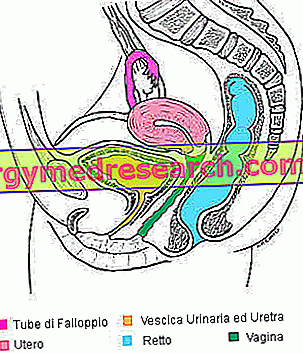The uterus is the female genital organ that:
- welcomes the fertilized egg cell and guarantees its development, providing all the nourishment necessary during the nine months of pregnancy
- favors the expulsion of the fetus at the time of delivery.
To perform these functions, the uterus undergoes cyclic changes that reflect the hormonal status of the woman.


The uterus is an unequal and hollow organ, located at the center of the small pelvis. It draws relationships with the bladder (anteriorly), with the rectum (posteriorly), with the intestinal loops (superiorly) and with the vagina (inferiorly).
The internal cavity of the uterus, its shape and the macroscopic characteristics of the organ, vary slightly from subject to subject. Furthermore, during the life span, the woman's uterus undergoes morphological and histological alterations in relation to numerous factors, both physiological (age, constitutional biotype, zero or multi-parity, period of the menstrual cycle, pregnancy, puerperium) and iatrogenic (hormonal therapies, surgical interventions and their outcomes) or pathological.
In the child and in the prepubere, the uterus has an elongated appearance, with a gloved finger.
In the adult woman it takes the form of a "pear upside down".
In post-menopause and in senile age the volume of the uterus gradually decreases and assumes an elliptical and flattened shape.

The uterus of an adult woman has the shape of an upturned pear, with the widest part at the top and the narrowest down, where it is related to the vagina. It has an average length of 7-8 cm, a transverse diameter of 4-5 cm, and an antero-posterior diameter of 4 cm; the weight is 60-70 g.
At the end of pregnancy, the total volume of the uterus can increase up to 100 times compared to the initial one and, overall, its weight reaches kg.
In the multipara, or rather in the woman who has had children, the triangular shape (inverted pear) is lost a little, since the uterus takes on a more globular appearance.
From the macroscopic point of view, the uterus is didactically divided into at least two regions, which have different structures, functions and diseases:
- body of the uterus : upper portion, more expanded and voluminous, about 4 cm long, rests on the urinary bladder
- cervix or uterine cervix : lower portion, smaller and narrower, about 3-4 cm long. It faces downwards, that is, it looks towards the vagina in which it protrudes through the so-called "tench snout".
in addition to these regions, they also identify:
- isthmus of uterus: narrowing that divides body and cervix
- bottom or base of the uterus: portion of the uterine cavity located above the imaginary line that connects the two fallopian tubes, facing towards the front


As shown in the figure, the relationship between body and cervix also varies with age: in the prepubere phase it is in favor of the neck (longer); over the years this relationship is reversed: at the menarche it is 1: 1 and then the body begins to overcome the neck both in terms of size and height and volume.
The first figure of the article, in addition to relations with neighboring organs, shows us the anatomical location of the uterus: The body is inclined to the neck with an anterior angle of about 120 degrees which gives rise to the antiflexion of the uterus; with the axis of the vagina, the neck forms an angle of about 90 degrees known as an anteversion. Overall, under normal conditions, the uterus therefore assumes an anti-void and anti-void position. → Deepening: retroverted, retroflected or retroversoflexed uterus
Histology and changes in the endometrium during the menstrual cycle
The uterus is an extremely dynamic organ, not only in the adaptations of shape and structure, but also from the point of view of the cells and tissues that compose it.
In the uterus wall we can recognize three important layers of tissue:
- endometrium (mucosa mucosa): superficial layer facing the uterine cavity; rich in glands, it is subject to periodic changes during the menstrual cycle
- myometrium (muscle layer): underlying layer, more often, consisting of smooth (involuntary) muscle tissue; it allows the uterus to dilate during pregnancy; at the time of birth, under the influence of oxytocin, it contracts to promote the birth of the newborn.
- Perimeter (serous tunic): peritoneal lining sheet, missing in the sides and in the supraginal portion of the cervix
The uterus (in particular its innermost layer or endometrium) is therefore the organ from which the periodic menstrual flow is derived during a woman's reproductive age. From puberty (11-13 years) up to menopause (45-50 years), the endometrium of the body and of the fund undergoes cyclical changes that occur every 28 days (approximately) under the influence of ovarian hormones:
- regenerative and proliferative phase (days 5-14): the uterine endometrium is gradually enriched with new cells and blood vessels, the tubular glands lengthen and overall the endometrium increases its thickness
- glandular or secretive phase (days 14-28): in this phase the endometrium reaches its maximum thickness, the cells become larger filling up with fat and glycogen, the tissue becomes oedematous → the uterus is functionally and structurally ready to receive the cell fertilized egg and to support it in its development;
- menstrual phase (days 1-4): the constant maintenance of the endometrium in a state favorable to the implant would be too expensive for the organism from the energy point of view. For this reason, if the egg cell is not fertilized, the most superficial layer of the endometrium undergoes necrosis, crumbling; the leakage of small quantities of blood and dead tissue residues gives rise to menstrual flow.
NOTE: at the level of the cervix, the mucosa does not undergo cyclic changes as striking as those described above. What varies is above all the mucous secretion of the cervical glands:
- generally very dense, to the point of forming a real cork that hinders the rise of the spermatozoa in the cervix, it becomes more fluid in the days around the ovulation, guaranteeing the sperm an easier access to the uterine cavity.
The mucous secretion of the uterine cervix also protects the innermost genital organs from ascending infections. During pregnancy, the cervix also functions as a mechanical support to prevent the premature exit of the fetus favored by gravity. Only at the time of delivery, while the uterine myometrium contracts under the stimulus of oxytocin, the cervix relaxes to let the fetus exit at term.



